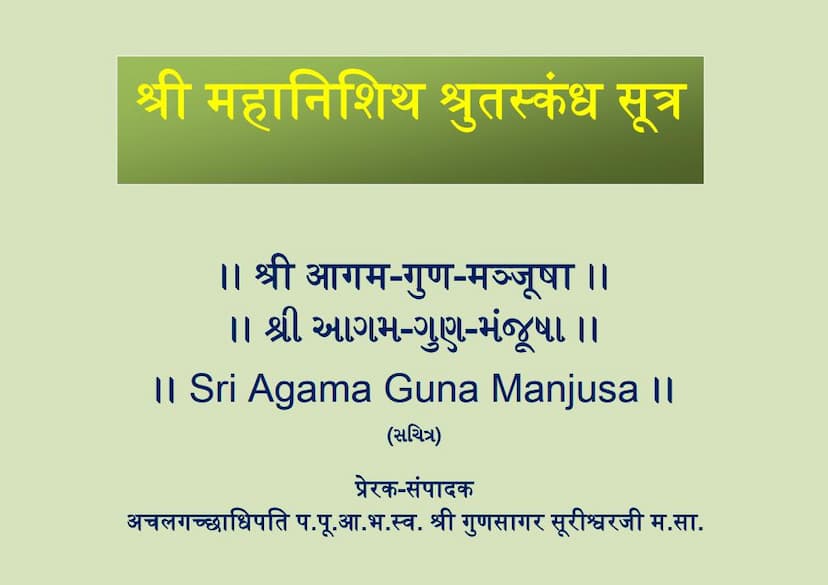Agam 39 Chhed 06 Maha Nishith Sutra Shwetambar Agam Guna Manjusha
Added to library: September 1, 2025

Summary
This document is a summary and partial text of the Jain scripture Maha Nishith Sutra (Great Night Sutra), also known as Agam 39, Chhed 06. The text is presented as part of the "Agam 3i Guna Manjusha" series, with inspiration and editing by Acharya Bhairav Swasti Shri Gunasagar Surishwarji Maharaj. The publisher is Jina Goyam Guna Sarvoday Trust, Mumbai.
The document provides a brief overview of the 45 Agamas (canonical scriptures) of Jainism, categorized into Angas, Upangas, Cheda Sutras, and other categories. It then delves into specific details about the Maha Nishith Sutra, highlighting its importance and the strict eligibility criteria for its study, which is restricted to highly qualified and disciplined monks.
Key aspects and content of the provided text:
-
Overview of 45 Agamas: The initial pages list and briefly describe the 11 Anga Sutras, 12 Upanga Sutras, and 6 Cheda Sutras, along with other classifications like Prakirnak Sutras, Chulikas, and Mala Sutras. This provides context for the place of the Maha Nishith Sutra within the broader Jain canon.
-
The Maha Nishith Sutra (Nishith Sutra):
- It is identified as one of the six Cheda Sutras, which are known for their in-depth discussion of rules, exceptions, and penances (ālocanā, utsarga, apavāda).
- The text explicitly states that the study of Cheda Sutras, particularly the Maha Nishith Sutra, is restricted to highly qualified monks who possess specific virtues like serenity, introversion, fear of worldly existence, self-control, profound insight, constant contemplation of protecting six-bodied beings, adherence to tradition, concern for the welfare of all beings, and have achieved special proficiency through yoga under their guru's guidance.
- The document indicates that the Maha Nishith Sutra itself is a profound text with severe penalties for transgressions and strict rules for conduct.
-
Detailed Text of Maha Nishith Sutra (Specific Chapters):
- The majority of the document is the actual text of the Maha Nishith Sutra, presented in Prakrit (with some Gujarati summaries and interpretations).
- Chapter 1 (Shalyoddharana - Extraction of Arrow/Remedy): Focuses on the concept of "Salla" (arrow, affliction, fault) and the process of removing it through introspection and penance. It emphasizes the need to be free from "Salla" for spiritual progress and liberation. It details various types of "Salla" and their consequences.
- Chapter 2 (Karma Vipaka Vivarana - Description of Karma Fruition): Discusses the consequences of actions (karma) and the suffering arising from them, including descriptions of various painful experiences in different realms of existence. It highlights the importance of virtuous conduct and penance to overcome karmic bondage.
- Subsequent Chapters (Ch. 3, 4, etc.): The text continues through various chapters and sections, detailing complex discussions on:
- Conduct and behavior of monks and nuns: Strict rules regarding food, possessions, interactions, and daily routines are outlined.
- Penances (Prayashchitta) and atonement: The text elaborates on the types of penances required for various transgressions, emphasizing purification of the self.
- The nature of 'Salla' (afflictions) and their eradication: A significant portion is dedicated to understanding and overcoming internal impurities and external afflictions.
- The concept of 'Gachchha' (monastic lineage/order) and its conduct: The text discusses proper conduct within the monastic community and the importance of adhering to the teachings of the Tirthankaras.
- The negative consequences of associating with 'Kushila' (unrighteous or corrupt individuals): The dangers of bad company and the adherence to correct spiritual paths are stressed.
- The importance of the Five Great Vows (Mahavratas) and their observance.
- Detailed philosophical discussions involving concepts like the soul, non-self, karma, liberation, and the path to it.
- The text also includes narratives and stories illustrating the principles discussed, often highlighting the consequences of actions and the rewards of virtuous living.
- The language is dense and highly technical, using specific Jain philosophical and procedural terminology, indicating its intended audience of advanced monastic scholars.
-
The Role of the Maha Nishith Sutra: The text emphasizes that this sutra is considered highly significant and difficult, containing secrets and profound knowledge essential for the spiritual journey of ascetics. Its study is a rigorous discipline, demanding utmost sincerity and adherence to rules.
In essence, the document provides a deep dive into a crucial and challenging scripture within the Svetambara Jain tradition, focusing on the intricate rules of monastic conduct, the consequences of actions, and the path to purification and liberation through strict adherence to vows and penances, particularly under the guidance of a qualified guru.